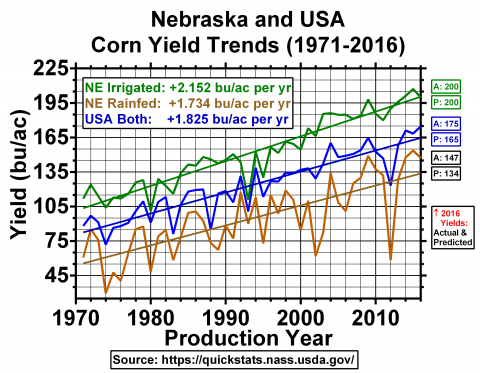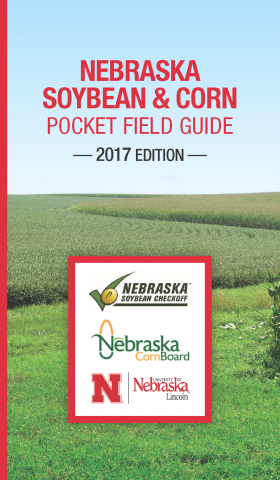Percent Corn (95%) and Soybean (76%) Planted near Long-Term Averages
June 1, 2017
For the week ending May 28, cool and mostly dry conditions prevailed, according to the USDA’s National Agricultural Statistics Service. Average temperatures ranged from three to nine degrees below normal. Some areas of the Panhandle and southeast Nebraska received up to an inch of rain; however, much of the state remained dry.
When Weather Delays Planting – Now What?
May 26, 2017
Agronomists consider several options for those pushed into late planting due to heavy rains. Changing corn hybrids or soybean varieties is not recommended, nor is shifting to alternate crops.
Soybean and Corn Yield and Acreage Trends through 2016
May 25, 2017
Nebraska soybean and corn yields steadily increased from 1971 to 2016, in both irrigated and rainfed production fields. Charts based on USDA National Agricultural Statistics Service numbers track these changes.
Postemergence (Rescue) Herbicide Options for Control of Glyphosate-Resistant Marestail in Corn and Soybean
May 24, 2017
Several factors have contributed to delayed applications and marestail escapes this spring. Includes recommendations for timely postemergence control in corn and soybean.
USDA NASS: Corn Planting at 34%, Soybean at 8%
May 1, 2017
Despite rainy cold conditions that moved in mid week, corn planting moved to 34% complete as of Sunday April 30, according to the USDA National Agricultural Statistics Services weekly Crop Progress and Condition Report. Eight percent of the soybean crop had been planted. For the week ending April 30, temperatures averaged eight to ten degrees below normal, according to the report. Significant rainfall of one inch or more was recorded across most counties. Moderate snow, averaging two to four inches, was recorded in south central and northeastern counties at the end of the week.
New Pocket Field Guide for Nebraska Soybean and Corn Growers
April 28, 2017
Nebraska farmers now have a new field resource to aid in identifying plant and pest problems in their soybean and corn fields. The Nebraska Soybean and Corn Pocket Field Guide provides information and photos to help farmers identify problems they may encounter during the growing season. The 380-page pocket-sized production guide was produced by a team of University of Nebraska researchers and Extension faculty, and funded by the Nebraska Soybean Board (NSB), Nebraska Corn Board (NCB), and the United Soybean Board (USB). Editors were Jim Specht, soybean physiologist/geneticist and University of Nebraska professor emeritus, and Tom Hoegemeyer, corn breeder and UNL adjunct professor of practice.
Considerations for Managing Herbicide-Resistant Weeds in Soybeans: Spring Burndown
April 28, 2017
One of the challenges with spring burndown application is timing. Wet and windy conditions can delay spraying and under these conditions weeds can grow significantly in a few days. Waiting until planting to spray troublesome weeds such as marestail may be too late to achieve adequate control. In addition, waiting until soybean planting limits the available herbicide options since there are relatively few labeled effective burndown chemicals for spraying at this time. The following section identifies key treatment aspects to consider for several resistant varieties in Nebraska.





